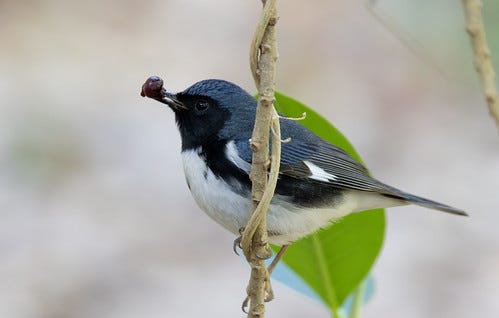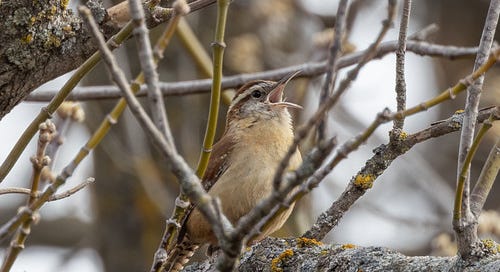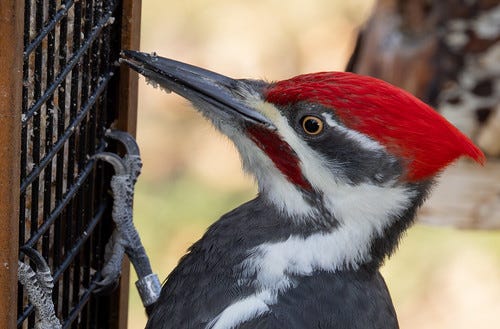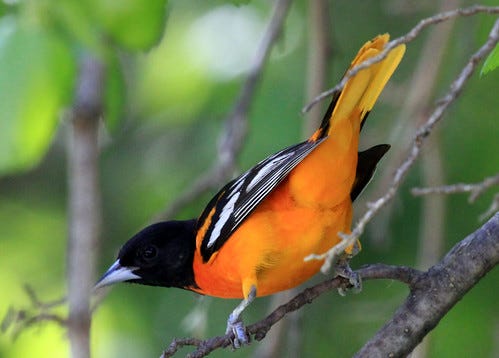(Listen to the radio version here.)

I’m looking out the window at drizzle and fog, the temperature hovering in the upper 30s. Many trees are budding, some almost ready to burst out in leaves, but I can’t see a single leaf yet. Today is supposed to reach the 50s, but tomorrow’s high will be back in the 40s, dropping again to the 30s tomorrow night. Then temps will bounce around, lows in the 40s and highs mostly in the 50s but sometimes the 60s for the next couple weeks.
When Russ and I lived in Madison, Wisconsin, these weather conditions were normal in early and sometimes even mid-April, but up here, they’re typical of early-to-mid-May. As much as I love balmy weather, I’m always happier with spring on the cold side like this. Yes, warblers arrive sooner when it’s warm, and they’re ever so much easier to see and identify before leaf-out, but they fuel their migration on the tiny caterpillars emerging on new leaves. If they arrive before the leaves do, they can be extremely stressed for calories. I much prefer insectivorous migrants to trickle in as conditions are likely to stay comfortable for them than for any of them to jump the gun and arrive before the last frigid conditions or late snowstorms are over.
An early Yellow-rumped Warbler showed up on March 18—that little guy spent quite a bit of time at my suet feeders. Unlike most other warblers, yellow-rumps can feed on berries and other items as well as insects. I’ve been gone for a week, but since I got home on April 28, I’ve had about half a dozen yellow-rumps each day. They don’t compete with the four dozen or so Pine Siskins taking Nyjer and sunflower. I suspect at least one pair of siskins is nesting in one of my conifers but haven’t been able to confirm it—unless the tiny nest is at eye level, it can be very hard to find, and even if I do locate a nest up high, seeing the contents is impossible for me.
On April 10, a most unexpected insectivore turned up on Park Point, a Carolina Wren! I charged out the moment I got the text message from Kim Eckert. When I arrived at the spot, he made some of the rolling trill calls I so love to hear, but by the time I got my phone out, he’d stopped doing that and was singing his full song. A whole group of birders were gathering, making clean recordings tricky, but I did get one reasonably good one. The bird kept his distance, but what a thrill!
While I was gone last week, Russ watched for BB and saw him most days, and I’ve seen him at least once a day every day since I got home. Russ saw a male and female together in the back of our yard last week, but he couldn’t get a glimpse at the male’s right leg to verify BB’s band. I suspect that BB does have a mate somewhere. Female woodpeckers select the nest site, and since I haven’t had a regular female in my yard since BB’s daughters moved on late last fall, he must be spending most of his time near the spot his mate chose. On the coldest mornings, he comes soon after it gets light outside, so the pair may very well be incubating eggs now—the male always has night duty, so by morning he’s probably ready for an easy, high-caloric breakfast he can count on.
I saw a Brown Thrasher at Park Point on April 14, but haven’t noticed any singing in my yard yet. Within the next two weeks, newly arriving birds will explode in color and song on Peabody Street—thrashers and catbirds, House Wrens, Baltimore Orioles, Rose-breasted Grosbeaks, Scarlet Tanagers, and Ruby-throated Hummingbirds. The first oriole and hummingbird tend to appear right about Mother’s Day, but I impatiently or optimistically set out a hummingbird feeder this morning. The Hummingbird Central migration map from this morning shows them well into Minnesota and Wisconsin already, but not quite here. Whenever he arrives (the first are invariably males) I want him to feel welcome.
I put out some orange pieces in case an oriole jumps the gun, too.
Sparrow migration has been rather pitiful in my yard so far. Juncos are still the most abundant, but I haven’t had any days with more than 25—most years I have at least a few days with 50 or even a hundred by now.
Every year is different, and even as some years we see more migrants than other years, and as some species slowly dwindle, birdwatching is always like that proverbial box of chocolate—you never know what you’re going to get, but it’s certain to be sweet.









